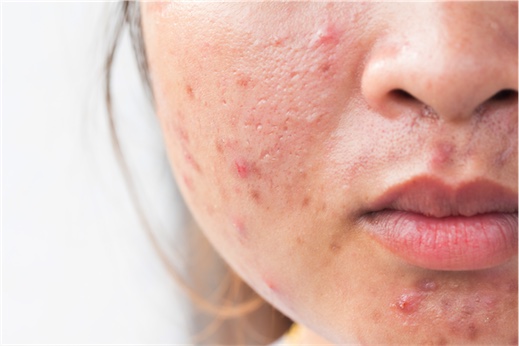Discover what drives your acne and get clear skin
Acne is an inside job (mostly) and to get clear, glowing skin we need to go “deeper than the dermis”.
If you’re a woman between 21-30, there’s a 45% chance you’ll have acne. It doesn’t completely disappear after you pass the big three zero. Acne can persist or return in your 40 and 50s.
There are cupboards full of topical acne treatments out there, but for lasting results, you need to identify the underlying cause/s and treat them. Often it’s not just one factor but a couple which
Rather than follow a “cookie cutter” protocol you’ll get the best results if you explore what factors are in play for you and address those.
What is acne?
Acne vulgaris is a common skin condition. Acne develops when the sebum (a waxy substance secreted from the sebaceous gland) undergoes inflammatory changes resulting in
While we all know beauty is not just skin deep having acne can put a big dent in self-esteem and quality of life.
The underlying causes
Following are a list of conditions which create the right environment for acne to erupt.
Hormones
Hormonally driven acne causes “blind” or cyst like eruptions on jawline, neck, shoulders, back
Any time hormones are changing can see this kind of acne rear its head -think puberty, pre-menstrually and perimenopause, PCOS and anyone taking supplemental testosterone. You can also get acne when coming off hormonal contraception especially if you were prescribed this for your skin. The oral contraceptive pill is usually not curative of acne. Once you stop it often comes back if the underlying issue wasn’t addressed.
Testosterone to DHT
When testosterone (both women and men have testosterone, but men’s levels are usually higher) gets converted to the more active dihydrotestosterone (DHT), this stimulates the sebaceous gland to make more sebum and sets the scene for acne to develop. High insulin, low progesterone (not ovulating) and some nutrient deficiencies increase DHT production.
Insulin-like growth factor 1
The hormone, insulin-like growth factor (IGF-1) also stimulates androgen receptors in the sebaceous causing increased sebum production. This hormone naturally increases during puberty, is stimulated by protein and is found in dairy products.
Sex hormone binding globulin
Sex hormone binding globulin (SHBG) is a protein which enables the body to “lock” up excess hormones to keep things balanced. Hypothyroidism, high insulin or liver damage decrease SHBG and can result in higher circulating androgens.
Estrogen
During peri-menopause, estrogen production decreases. Estrogen inhibits excessive stimulation of the sebaceous glands and also helps increase insulin sensitivity.
Other things which may lower estrogen include high levels of exercise and body fat in females <18%.
Diet
Dairy
Dairy can cause a problem for skin in two ways. As discussed above, dairy increases IGF-1 which both stimulates androgen receptors and magnifies insulin levels by 2-3 times. It is also a food that is poorly tolerated by many and can lead to an inflammatory state in the body.
Refined sugar and simple carbs
These increase insulin and encourage inflammation in the body. Filling up on sugary calories often means you won’t be getting sufficient nutrients needed for skin health.
Bad oils
Transfats and excessive consumption of omega 6- vegetable and seed oils create inflammation in the body. Margarine, crackers, store-bought baked goods are common sources of trans fats. Inflammatory oils include sunflower, canola and vegetable oil.
Food intolerance
If you are intolerant to certain foods, this causes inflammation and can trigger acne formation.
Stress
Acne related to stress is often found on the cheeks and forehead. It may present as cysts; small flesh
The skin has receptors for cortisol ( the primary stress hormone), so it’s no surprise that many of us “wear our stress on our skin”.
The elevated cortisol associated with chronic stress also knocks other hormones out of balance including insulin, estrogen
Stress can also contribute to food intolerance by weakening the protective mucous layer in the intestines and reducing the output of digestive enzymes.
Poor digestion
Along with our bowels and kidneys, the skin has a role in detoxification. Acne can occur when other detoxification pathways are sluggish.
Damage to the liver, kidneys and even slow intestinal transit time (constipation) can all contribute to acne.
Blockages/Toxins
Physical blockage can also contribute to the formation of acne especially if other conditions are also present.
- Sunscreens – certain sunscreens are more prone to this than others.
- Beauty products containing parabens, fragrances, benzoic acid, benzoyl peroxide (often a key ingredient in many topical acne treatments).
Comodome promoting oils such as coconut, palm oiland sodium laurylsulphate - Heavy, synthetic clothing especially if you sweat a lot in it. Choose natural
fibres and change out of work out wear as soon as you can. - Smoking
Harsh or too frequent cleaning
Like the digestive tract, the skin has its own microbiome. The skin requires a slightly acidic pH to keep things in balance and avoid the proliferation of the bacteria which cause large inflamed acne lesions.
Avoid harsh astringent cleansers and don’t go overboard on washing the skin.
Genetics
While there is no “acne gene” there is often a strong family history. A 2018 study suggests people at a higher risk for acne may have genes which predispose them to higher androgen levels and sebum production. This is an area of ongoing research.
Acne as a symptom
These are some of the driving forces behind acne formation. I think of acne as a symptom, a signpost for something else going on. Going “deeper than the dermis” will not only give you clear skin, you’ll also improve your overall health.
This post is part of a 5-part series on acne treatment.
Part 2 – What diet should I use to help my acne?
Part 3 – A guide to herbs for acne
Part 4 – What vitamins are best for acne?
Part 5 – Side effects of isotretinoin

Need help with your skin?
Norelle Hentschel is an experienced Naturopath with a clinic in Stones Corner, South East Brisbane and also offers Telehealth consults Australia wide. She enjoys supporting her clients to reach their health goals.
Want more articles like this?
Join us at Your Skin Remedy – the monthly missive for healthy skin from the inside out. Practical, actionable, and informative. Your clear, glowing skin starts here.
PS. Your inbox real estate is precious. Your Skin Remedy is pitch and promo free. I promise. One email a month — that’s it.

